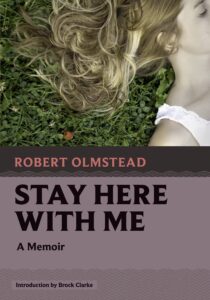
Exposing Vulnerability: On Robert Olmstead's Stay Here with Me
"It is contrary, it cuts against the grain, including the grain of Olmstead’s own work."
I first met Robert Olmstead in January 1987. He was the teacher of my introductory fiction workshop at Dickinson College in Carlisle, Pennsylvania. Back then you were allowed to smoke cigarettes in class, and if you were a person like me, you not only smoked cigarettes in class, you chain-smoked cigarettes in class. I should explain what it meant to be a “person like me”: a person like me was a person who tried too hard. And I was the worst kind of person who tried too hard: I was the kind of person who didn’t know what person I was trying too hard to be, and so I tried too hard to be a lot of them. And one of the people I tried too hard to be was Robert Olmstead.
At that point, Olmstead had written two books—the short story collection River Dogs and the novel Soft Water—and soon after he would publish his novel A Trail of Heart’s Blood Wherever We Go. These three books were, and, as far as I’m concerned, still are, among the very best fiction to come out of northern New England: they are tough, wise, terse; they are violent of deed and lovely of phrase. They are, like the winters in Olmstead’s native New Hampshire, fearsome. As was Olmstead himself: with his big red beard and his flannel and his taciturnity, he seemed to me the quintessential northern American writer. Which is to say, he was what I wanted to see, and what I wanted to be. Which is to say, I wanted to be authentic, just like Olmstead.
I was the kind of person who didn’t know what person I was trying too hard to be, and so I tried too hard to be a lot of them.
As everyone knows—well, apparently not everyone—you cannot try to be authentic. I mean, you can try, but you will fail. And when you fail, if you are the kind of person I was, you will blame not yourself; instead, you will blame the person you were trying to be.
The first story I handed in to workshop was, I believe, a story about a young man from a dying a mill town in upstate New York (I was from a dying mill town in upstate New York) who wore flannel and who smoked cigarettes and brooded. About what, I don’t remember. It might have been about the cigarettes.
About that story, Olmstead said several understatedly unimpressed things that were not untrue.
I sulked and snarked and smoked my way through the rest of the semester. And then Olmstead and I didn’t speak to or see each other again for twenty-one years.
*
You won’t find a better book about New England than Olmstead’s 1996 memoir Stay Here with Me. For instance, this passage:
New England is still, for the most part, on a human scale, which is to say the land does not require you to confront it. It is not so blank as to make you turn to depend on your mind, not so huge that you are dwarfed, not so hospitable that you become wasteful, not so brutal that you die. But of course it’s none of this; it’s me remembering where I was born and raised and where, for better or worse, I learned to live.
Everything that is great about the book is in evidence in this passage: it says a new true thing about a region so talked about, so mythologized (and self-mythologized) that you wouldn’t think there was a new true thing to be said about it. In other words, it is authoritative. And then it undercuts that authority by immediately saying that this true thing, this brilliant, insightful, authoritative true thing that has just been said, is in fact entirely personal. Which is to say, subjective. Which is to say, untrue, or at least unreliable. Which makes it even more beautiful than it already was, and it was already plenty beautiful.
Plus, it’s very funny. “But of course it’s none of this.” That makes me laugh every time.
Stay Here with Me is the book I’m here to praise, but I fear I’ve taken an out-of-order approach to doing so. But maybe that’s apt. The passage I’ve quoted above, for instance, seems like it should be at the very beginning of a book. But, in fact, it’s at the very end of Stay Here with Me. And this is one of the things I love most about this book: it is contrary, it cuts against the grain, including the grain of Olmstead’s own work. Much of Olmstead’s fiction—both the work set in New England and elsewhere—is violent, and that violence—or at least the potential for that violence—makes the fiction unbearably tense, and that tension is ratcheted up by his terrifically taut plotting. But compared to those other books, this—his only memoir—is fond, and positively loose-limbed. It is about the last summer Olmstead spent at his family farm in New Hampshire before heading off to a year of prep school before college. And it is also about a slightly older college student named Afton, a beautiful, mysterious woman who would seem out of Olmstead’s league and whom Olmstead of course has fallen in love with. Afton is introduced in the book’s beautiful opening scene, and we can already hear the ticking clock on their relationship, and the summer, and Olmstead’s life as he’s known it.
That would seem book enough.
Except that Olmstead takes every opportunity to write about almost everything else: with the liberal and exhilarating use of flash-forwards, Olmstead tells us about his two friends who help out on the farm and who are headed for dramatically different ends to dramatically different lives; about his father, who does not work on the farm and who is drinking himself to death, which does not cause Olmstead to love him less or write about him less generously; about his mother and grandmother, whose constancy seemingly sets them up to be ignored and underappreciated, except that with his wandering eye and attention Olmstead does not ignore them and does appreciate them; about the farm itself, and the land around it, which Olmstead treats with equal parts fear, hope, boredom, resentment, and wonder; about his cancer-ridden taskmaster of a grandfather, who is one of the grand characters in contemporary American literature and who is the source of much comedy and friction in this book and about whom Olmstead writes, “He enjoyed his mind better than anyone I ever knew.” I will never forget that sentence. I know people like that, and you know people like that, but you and I don’t know anyone who has described them in one short sentence the way Olmstead describes his grandfather.
Which is not to say that the book forgets about Afton. But it is to say that her absences make the reader especially glad to see her reappear. Because when she does, we learn a lot—about her, certainly, but also about Olmstead as a writer. I was shocked when I first read this book. For one, there is enough sex in it to cause the Yankee authorities to tie up Olmstead on the town green and have the citizens stone him with their copies of Ethan Frome. For another, Olmstead the character and Olmstead the writer are such kind presences, such good listeners, so curious and open-hearted and-minded—when it comes to Afton, certainly, but really when it comes to everyone in this book. And as much as I loved his earlier books—and I did love them and I still do love them, and the later books, too—I did not remember in them those qualities. And I did not remember those qualities in Olmstead’s classroom, either.
It made me wonder how in the world the Olmstead I knew, or thought I knew, could also be the Olmstead who wrote Stay Here with Me.
My point is not that they weren’t there. My point is that I was too blindered by my own particular fixations and insecurities and limitations to see them.
No surprise, then, that I have returned to this book several times over the years—with gratitude, the way you do with a book great enough to teach you something about the world, and about yourself, about the writer who made it and about his other books, but also with wonder.
And what did Stay Here with Me make me wonder? It made me wonder how in the world the Olmstead I knew, or thought I knew, could also be the Olmstead who wrote Stay Here with Me.
*
Twenty-one years after I got a B in Robert Olmstead’s introductory fiction class, he invited me to give a reading at Ohio Wesleyan University, where he was then teaching. As I said, we had not spoken in all that time. I was happy Olmstead invited me; I was also nervous. Who knew how we would get along? And for that matter, who knew how Olmstead would feel about my new novel—An Arsonist’s Guide to Writers’ Homes in New England—a book that wasn’t exactly reverent about the world he had written about so beautifully.
“Brock was my student, a long time ago,” Olmstead said in his introduction to my reading, “and I didn’t know what to think about him, and I’m sure he didn’t know what to think about me, either.”
This sounds ominous, but Olmstead said it sweetly, laughingly and his face, which was now beardless, looked cherubic. There he was, the Olmstead who had written the book in your hands or on your screen. But I still didn’t know how he’d done it, or where this Olmstead had come from, until later that night, when I asked Olmstead why he’d shaved his beard, and he said that he was sick of people being scared of him. “People now come up to me in the grocery just to make small talk!” Olmstead said, laughing, obviously so happy. “Strangers!”
Of course, he was the same Olmstead he’d always been. He had just done something different to make you see it. And that’s when I realized what makes this book so different, and why I love it, and why I bet you’ll love it, too: Stay Here with Me was the book when Olmstead cut off his beard.
______________________________

Introduction from Stay Here With Me by Robert Olmstead, published by David R. Godine Publisher. Copyright © 2024 by Brock Clarke. Reprinted with the permission of the publisher.
Brock Clarke
Brock Clarke is the author of seven works of fiction, including the bestselling An Arsonist's Guide to Writers' Homes in New England, as well as the essay collection I, Grape; or The Case for Fiction. He lives in Maine and teaches at Bowdoin College.



















